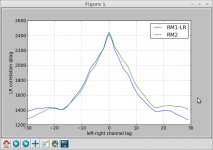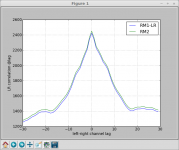This one is different, very different 
What we have here is a recording made by taking the output directly from across the speaker terminals... in other words the real voltage from an amplifier as it appears across the speaker.
How do you listen and evaluate such a "test" ? Answer... I don't know. Are headphones a realistic option ? I suspect not because when I replay these through headphones the "effect" or differences are obscured to a large extent and don't come across. On speakers then ? Well probably. The two files are chalk and cheese when auditioned this way. Maybe "tests" done this way could be more revealing of how close an amp comes to a piece of wire than all conventional testing.
Two different amplifiers were used in the test. The listening level was "moderate" (but matched between amplifiers) and the speakers are B&W703's that have a 3ohm impedance minima.
https://www.dropbox.com/s/h74vg3x5i4qcf1z/RM1A.wav
https://www.dropbox.com/s/ssl4yuz1v66dgco/RM2A.wav
What are your impressions, I'd like to know
What we have here is a recording made by taking the output directly from across the speaker terminals... in other words the real voltage from an amplifier as it appears across the speaker.
How do you listen and evaluate such a "test" ? Answer... I don't know. Are headphones a realistic option ? I suspect not because when I replay these through headphones the "effect" or differences are obscured to a large extent and don't come across. On speakers then ? Well probably. The two files are chalk and cheese when auditioned this way. Maybe "tests" done this way could be more revealing of how close an amp comes to a piece of wire than all conventional testing.
Two different amplifiers were used in the test. The listening level was "moderate" (but matched between amplifiers) and the speakers are B&W703's that have a 3ohm impedance minima.
https://www.dropbox.com/s/h74vg3x5i4qcf1z/RM1A.wav
https://www.dropbox.com/s/ssl4yuz1v66dgco/RM2A.wav
What are your impressions, I'd like to know
Last edited:
The playback equipment, used when listening to wav#1 and wav#2, might obscure the differences (if any). I suppose the playback equipment might accentuate the differences (if any). Why not simply subtract the two waveforms and compare against zero? Or listen to the subtracted result?
If for example the playback equipment's "resolution" were 3 bits (SNR = 18 dB), it would obscure all differences.
Sorry if this is the 500th time the query has been raised.
If for example the playback equipment's "resolution" were 3 bits (SNR = 18 dB), it would obscure all differences.
Sorry if this is the 500th time the query has been raised.
and probably even higher count for for the explanation that the real conditionals attached to "all amps sound alike" is that they sound alike when they do give the same V at the speaker terminals
and recognizes that some amps do have audible output Z interaction with speaker loads and can sound different from other amps with different output Z with some speaker loads
the Carver/Stereophile Challenge is a clear example of matching "very different" amplifiers with output Z padding, minor feedback tweaks to eliminate audible differences in DBT listening
and recognizes that some amps do have audible output Z interaction with speaker loads and can sound different from other amps with different output Z with some speaker loads
the Carver/Stereophile Challenge is a clear example of matching "very different" amplifiers with output Z padding, minor feedback tweaks to eliminate audible differences in DBT listening
The playback equipment, used when listening to wav#1 and wav#2, might obscure the differences (if any). I suppose the playback equipment might accentuate the differences (if any). Why not simply subtract the two waveforms and compare against zero? Or listen to the subtracted result?
If for example the playback equipment's "resolution" were 3 bits (SNR = 18 dB), it would obscure all differences.
Sorry if this is the 500th time the query has been raised.
Well, this is the problem... how do you evaluate what you hear in a test like this. Perhaps as a new test method there could be some validity in it though. If you have an original source and also the voltage across the real speaker then that is a golden opportunity to strive for the perfect amplifier... the piece of wire with gain. If the two defied reasonable differentiation then the amp has to be doing something right.
The two files in this thread were really an experiment... but I'm surprised just how different the sonic result of each is when played back via speakers. There is no subtlty here,the difference is huge. To say that amplifiers used within their performance envelope are broadly similar clearly isn't the case as this demonstrates.
and probably even higher count for for the explanation that the real conditionals attached to "all amps sound alike" is that they sound alike when they do give the same V at the speaker terminals
and recognizes that some amps do have audible output Z interaction with speaker loads and can sound different from other amps with different output Z with some speaker loads
the Carver/Stereophile Challenge is a clear example of matching "very different" amplifiers with output Z padding, minor feedback tweaks to eliminate audible differences in DBT listening
That's a good point. By pure coincidence both amplifiers have 0.22 ohm series output resistors as standard. In practical terms that means that both should have essentially identical output impedances whatever the differences of the circuitry. The 0.22's would swamp those differences.
on simple computer moniters, the first one sounds a little more forward in the midrange and seems to maintain itself s little better when the things get a little more complicated. The second seems to get a little compressed as things pick up. Just a drive by, as the speakers used to reproduce are less than ideal. I would say first amp is holding up a little better.
on simple computer moniters, the first one sounds a little more forward in the midrange and seems to maintain itself s little better when the things get a little more complicated. The second seems to get a little compressed as things pick up. Just a drive by, as the speakers used to reproduce are less than ideal. I would say first amp is holding up a little better.
A lot of fun Karl, thanks! 

The difference is soo huuuuge in this test. I am posting a 10/10 ABX result, but would make 100/100 this time.
Briefly:totally different space. Voice is almost in the middle for RM1, but shifted right in RM2. Different tonality, different soundstage. What are those horrible power amps under test?
Long live Elton's Rocket Man
The difference is soo huuuuge in this test. I am posting a 10/10 ABX result, but would make 100/100 this time.
Briefly:totally different space. Voice is almost in the middle for RM1, but shifted right in RM2. Different tonality, different soundstage. What are those horrible power amps under test?
Long live Elton's Rocket Man
Attachments
Last edited:
You are right spiri, channels are probably reversed in one of the files.
I just peeked at the waveforms in audacity and you are right.
Oops.
The ABX I did earlier after de-inverting the channels was wrong, I had actually not inverted the channels. Fixed.
Now, comparing the two files, the voice does not move left/right anymore. But the differences in imaging/ambience are enough to score 100%...
Here is the interchannel correlation for both files, with channels fixed, this time it looks really identical.
The ABX I did earlier after de-inverting the channels was wrong, I had actually not inverted the channels. Fixed.
Now, comparing the two files, the voice does not move left/right anymore. But the differences in imaging/ambience are enough to score 100%...
Here is the interchannel correlation for both files, with channels fixed, this time it looks really identical.
Attachments
Last edited:
IMO, the test is entertaining but not very enlightening. A question- have you tried this by tapping the signal at the speaker end of the cable, vs the amplifier end? That might be an interesting comparison, especially considering the 3 ohm minimum and if the cables are smaller than 12 gauge!
RM2 appears to have the channels switched. The voice also seems to drift slightly to the right. I'll switch channels and compare it with RM1 tomorrow on the main speakers. I've been listening to it on the computer speakers ( 3" !).
On the first pass RM1 appeared to have slightly more HF content ( harmonics ?). Need to confirm that with the main system tomorrow. RM2 appeared to sound slightly dull compared to RM1. Then I moved all reflective surfaces away from the speakers and tried again and found it harder to say what the difference was ! So I'll check it tomorrow. Have to go to bed now.
You are recording the electrical signal across the speaker terminals I think. Not off a mic I'm sure ....?
On the first pass RM1 appeared to have slightly more HF content ( harmonics ?). Need to confirm that with the main system tomorrow. RM2 appeared to sound slightly dull compared to RM1. Then I moved all reflective surfaces away from the speakers and tried again and found it harder to say what the difference was ! So I'll check it tomorrow. Have to go to bed now.
You are recording the electrical signal across the speaker terminals I think. Not off a mic I'm sure ....?
Last edited:
- Status
- This old topic is closed. If you want to reopen this topic, contact a moderator using the "Report Post" button.
- Home
- General Interest
- Everything Else
- Listening Test... A Practical Demonstration That Amplifiers Have Their Own Sound.


